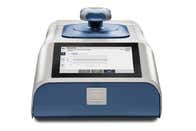
Micromeritics AccuPyc
The fastest, easiest, most accurate measurement of true density
True density vs skeletal density: Exploring the difference
True density, also known as absolute density, refers to the density of a material excluding all pores, voids, and cracks. It is the intrinsic density of the solid material itself.
True density is the mass divided by the true volume.
Skeletal density includes the density of the material as well as any inaccessible pores or closed pores.
It is defined as the mass divided by the skeletal volume.
True density is calculated as:
True density (ρt) = Mass / True volume
Key DifferencesTrue volume excludes the volume of all pores (open and closed) and measures only the solid material.
Skeletal density is calculated as:
Skeletal density (ρs) = Mass / Skeletal volume
Key DifferencesSkeletal volume excludes the volume of open, accessible pores, but includes the volume of closed pores.
Skeletal density is often determined by measuring skeletal volume using gas pycnometry. The true volume can be measured and true density determined as long as there are no closed pores in the material.

The fastest, easiest, most accurate measurement of true density
The Micromeritics AccuPyc utilizes gas pycnometry, a non-destructive technique that accurately measures volume through gas displacement, making it ideal for determining skeletal and, when appropriate, true (absolute) volume and density. It is only appropriate for true density when there are no closed pores. Inert gases such as helium, nitrogen, or air are commonly used as the displacement medium as not to interact with the sample.
During measurement, the sample is placed in a sealed chamber of known volume and pressurized. The gas fills the empty spaces within and between the sample particles before expanding into an adjacent reference chamber of known volume. The resulting pressure change allows for precise volume calculation. Skeletal density is then determined by dividing the sample's mass by its measured volume. This method is particularly effective for characterizing materials with small pores and irregular shapes.

The fastest, easiest, most accurate measurement of true density
As a unified company, Micromeritics and Malvern Panalytical blend advanced technologies with analytical expertise. The Micromeritics AccuPyc gas pycnometer is globally recognized for delivering the most reliable determination of skeletal density. It is the preferred choice in more labs than any other commercial gas pycnometer.
Offering unmatched accuracy and repeatability, the AccuPyc provides a fast, user-friendly system that ensures consistent results.